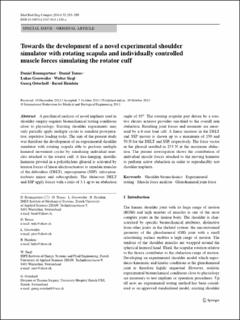Please use this identifier to cite or link to this item:
https://doi.org/10.21256/zhaw-4912Full metadata record
| DC Field | Value | Language |
|---|---|---|
| dc.contributor.author | Baumgartner, Daniel | - |
| dc.contributor.author | Tomas, Daniel | - |
| dc.contributor.author | Gossweiler, Lukas | - |
| dc.contributor.author | Siegl, Walter | - |
| dc.contributor.author | Osterhoff, Georg | - |
| dc.contributor.author | Heinlein, Bernd | - |
| dc.date.accessioned | 2018-11-30T10:03:56Z | - |
| dc.date.available | 2018-11-30T10:03:56Z | - |
| dc.date.issued | 2013-03 | - |
| dc.identifier.issn | 0140-0118 | de_CH |
| dc.identifier.issn | 1741-0444 | de_CH |
| dc.identifier.uri | https://digitalcollection.zhaw.ch/handle/11475/13407 | - |
| dc.description | Erworben im Rahmen der Schweizer Nationallizenzen (http://www.nationallizenzen.ch) | de_CH |
| dc.description.abstract | A preclinical analysis of novel implants used in shoulder surgery requires biomechanical testing conditions close to physiology. Existing shoulder experiments may only partially apply multiple cycles to simulate postoperative, repetitive loading tasks. The aim of the present study was therefore the development of an experimental shoulder simulator with rotating scapula able to perform multiple humeral movement cycles by simulating individual muscles attached to the rotator cuff. A free-hanging, metallic humerus pivoted in a polyethylene glenoid is activated by tension forces of linear electroactuators to simulate muscles of the deltoideus (DELT), supraspinatus (SSP), infraspinatus/teres minor and subscapularis. The abductors DELT and SSP apply forces with a ratio of 3:1 up to an abduction angle of 85°. The rotating scapular part driven by a rotative electro actuator provides one-third to the overall arm abduction. Resulting joint forces and moments are measured by a 6-axis load cell. A linear increase in the DELT and SSP motors is shown up to a maximum of 150 and 50 N for the DELT and SSP, respectively. The force vector in the glenoid resulted in 253 N at the maximum abduction. The present investigation shows the contribution of individual muscle forces attached to the moving humerus to perform active abduction in order to reproducibly test shoulder implants. | de_CH |
| dc.language.iso | en | de_CH |
| dc.publisher | Springer | de_CH |
| dc.relation.ispartof | Medical & Biological Engineering & Computing | de_CH |
| dc.rights | Licence according to publishing contract | de_CH |
| dc.subject | Biomechanical phenomena | de_CH |
| dc.subject | Equipment design | de_CH |
| dc.subject | Humerus | de_CH |
| dc.subject | Polyethylene | de_CH |
| dc.subject | Articular range of motion | de_CH |
| dc.subject | Rotator cuff | de_CH |
| dc.subject | Scapula | de_CH |
| dc.subject | Shoulder | de_CH |
| dc.subject | Shoulder joint | de_CH |
| dc.subject.ddc | 610: Medizin und Gesundheit | de_CH |
| dc.title | Towards the development of a novel experimental shoulder simulator with rotating scapula and individually controlled muscle forces simulating the rotator cuff | de_CH |
| dc.type | Beitrag in wissenschaftlicher Zeitschrift | de_CH |
| dcterms.type | Text | de_CH |
| zhaw.departement | School of Engineering | de_CH |
| zhaw.organisationalunit | Institut für Mechanische Systeme (IMES) | de_CH |
| dc.identifier.doi | 10.21256/zhaw-4912 | - |
| dc.identifier.doi | 10.1007/s11517-013-1120-z | de_CH |
| dc.identifier.pmid | 24170552 | de_CH |
| zhaw.funding.eu | No | de_CH |
| zhaw.issue | 3 | de_CH |
| zhaw.originated.zhaw | Yes | de_CH |
| zhaw.pages.end | 299 | de_CH |
| zhaw.pages.start | 293 | de_CH |
| zhaw.publication.status | publishedVersion | de_CH |
| zhaw.volume | 52 | de_CH |
| zhaw.publication.review | Peer review (Publikation) | de_CH |
| Appears in collections: | Publikationen School of Engineering | |
Files in This Item:
| File | Description | Size | Format | |
|---|---|---|---|---|
| 2014_Baumgartner_Towards_the_development_of_a_novel_experimental_shoulder_simulator.pdf | 762.24 kB | Adobe PDF |  View/Open |
Show simple item record
Baumgartner, D., Tomas, D., Gossweiler, L., Siegl, W., Osterhoff, G., & Heinlein, B. (2013). Towards the development of a novel experimental shoulder simulator with rotating scapula and individually controlled muscle forces simulating the rotator cuff. Medical & Biological Engineering & Computing, 52(3), 293–299. https://doi.org/10.21256/zhaw-4912
Baumgartner, D. et al. (2013) ‘Towards the development of a novel experimental shoulder simulator with rotating scapula and individually controlled muscle forces simulating the rotator cuff’, Medical & Biological Engineering & Computing, 52(3), pp. 293–299. Available at: https://doi.org/10.21256/zhaw-4912.
D. Baumgartner, D. Tomas, L. Gossweiler, W. Siegl, G. Osterhoff, and B. Heinlein, “Towards the development of a novel experimental shoulder simulator with rotating scapula and individually controlled muscle forces simulating the rotator cuff,” Medical & Biological Engineering & Computing, vol. 52, no. 3, pp. 293–299, Mar. 2013, doi: 10.21256/zhaw-4912.
BAUMGARTNER, Daniel, Daniel TOMAS, Lukas GOSSWEILER, Walter SIEGL, Georg OSTERHOFF und Bernd HEINLEIN, 2013. Towards the development of a novel experimental shoulder simulator with rotating scapula and individually controlled muscle forces simulating the rotator cuff. Medical & Biological Engineering & Computing. März 2013. Bd. 52, Nr. 3, S. 293–299. DOI 10.21256/zhaw-4912
Baumgartner, Daniel, Daniel Tomas, Lukas Gossweiler, Walter Siegl, Georg Osterhoff, and Bernd Heinlein. 2013. “Towards the Development of a Novel Experimental Shoulder Simulator with Rotating Scapula and Individually Controlled Muscle Forces Simulating the Rotator Cuff.” Medical & Biological Engineering & Computing 52 (3): 293–99. https://doi.org/10.21256/zhaw-4912.
Baumgartner, Daniel, et al. “Towards the Development of a Novel Experimental Shoulder Simulator with Rotating Scapula and Individually Controlled Muscle Forces Simulating the Rotator Cuff.” Medical & Biological Engineering & Computing, vol. 52, no. 3, Mar. 2013, pp. 293–99, https://doi.org/10.21256/zhaw-4912.
Items in DSpace are protected by copyright, with all rights reserved, unless otherwise indicated.